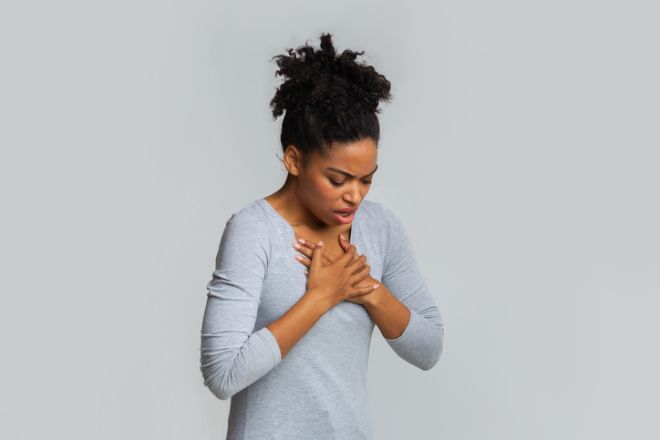4 Warning Signs You're Overtraining And When To Hit Pause
Overdoing It At the Gym? 4 Signs You’re Training Too Hard
Share the post
Share this link via
Or copy link

You’re deep into an intense workout when a burning sensation starts to creep into your muscles, but is it just normal post-exercise soreness or the warning signs of an injury? Knowing whether to push through the discomfort or stop and reassess can be tricky. According to health experts, the key often comes down to understanding your body’s signals and recognizing your pain threshold.
“When people understand their pain and what’s normal and not normal, they really benefit,” Dave Pavao, the chief clinical officer of Highbar Physical Therapy, told SELF on June 23. “Distinguishing discomfort from pain allows you to make the right decisions and stay in the game longer instead of getting into trouble.”
If you’re not sure whether what you’re feeling is normal post-exercise soreness or something more serious, these four signs can help you tell the difference.
1. Swelling or muscles tender to the touch

Love MadameNoire? Get more! Join the MadameNoire Newsletter
We care about your data. See our privacy policy.
Soreness after a tough workout is normal, especially if you’re new to exercise or ramping up intensity. This discomfort is usually caused by small micro-tears in your muscles, a process that actually helps you build strength as your body repairs them. This type of soreness, known as Delayed Onset Muscle Soreness (DOMS), typically appears 24–48 hours after your workout and subsides within a week.
But if your muscles feel tender to the touch, extremely tight, or appear swollen or bruised, that’s different. It may signal inflammation beyond what is considered normal, or even an injury.
“My rule of thumb is If you have an achy pain that lasts for a couple of days then goes away, that’s fine, and will most likely lessen as you continue to get more fit,” shared Sarah Kennedy D.O., an orthopedic physician and family medicine doctor at Texas Health Arlington Memorial during an interview with Texas Health Resources. “If it’s lasting longer than that, you should probably back off. If it’s a sharp, severe pain, as in you rate it a seven out of 10 or above on the pain scale, then that’s a no-go,” she added.
If the swelling or tight sensation in your muscles is accompanied by limping or soreness lasting longer than a week, it may also be a sign that you’re dealing with an injury rather than typical soreness, Kennedy added. Don’t be afraid to pay a visit to your primary care doctor to have a look.
RELATED CONTENT: Gym Etiquette 101: 10 Rules Every Respectful Member Should Follow
2. Chest pain or severe shortness of breath

During intense workouts, it’s normal to breathe hard and feel your heart pounding — that’s part of the effort. But persistent chest pain or shortness of breath that doesn’t ease up when you slow down is not.
In rare cases, this could signal a heart issue or even a cardiac event, especially if the symptoms feel dramatically different from your usual experience. For example, if you’re someone training for a marathon who suddenly can’t finish a run due to chest pain, that’s a red flag, Dr. Ashley Austin, a sports medicine physician, told SELF. But a beginner getting out of breath during early workouts isn’t usually cause for concern.
If chest tightness, breathlessness, or burning in the chest continues after exercise or worsens, it’s time to stop and get checked out.
3. Shooting pain, numbness, or tingling

Soreness that stays in one area — like your quads after a leg day — is expected. But if pain radiates from your back down your leg, or from your neck down your arm, it could be a sign of nerve compression or damage. Likewise, if you feel numbness, tingling, or pins and needles, that’s a sign that something deeper is going on, often involving your spine or a pinched nerve.
Don’t ignore nerve-related injury symptoms. Left untreated, they can lead to chronic pain or long-term damage. If pain is accompanied by unusual sensations or travels, consult a healthcare provider.
4. Dark urine and muscle weakness after intense exercise

One of the most serious signs of overtraining is dark-colored urine, especially if it’s paired with muscle pain, stiffness, or weakness, warned Dr. Kennedy. These can be symptoms of rhabdomyolysis, a rare but dangerous condition where muscle fibers break down rapidly, releasing proteins into the bloodstream. If not treated quickly, it can lead to kidney damage, according to Orlando Health.
This condition is most commonly seen after extreme or prolonged workouts, especially in hot conditions or when hydration is lacking. If you experience any of these symptoms, seek medical attention immediately.
Final thoughts: Listen to your body.

Training hard is commendable, but rest and recovery are just as crucial as the effort itself. Soreness is a regular part of getting stronger, but pain, swelling, and lingering symptoms should never be ignored.
If something feels off, it probably is. Don’t “tough it out” when your body is asking you to slow down. A short break now can prevent a long-term injury later.
RELATED CONTENT: No Pain, Still Gain: Why Soreness Isn’t The Only Sign Of A Great Workout
-

My Husband And I Attempted To Have A Creative Date Night At Home -Without A Babysitter - Here's How It Went
-

Our Health, Our Power: Debunking Myths And Taking Charge This Open Enrollment
-

Dear Christians, Your Reaction To Dr. Karri Bryant's Dress Is Partly Why People Don’t Do Church [Op-Ed]
-

8 Famous Lesbian Women Who Were Married To Men



